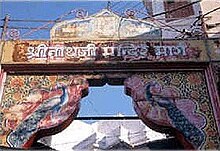The svarupa or divine form of Shrinathji is said to be self-manifested.The deity of the Krishna according to the legend, is self-manifested from a stone and emerged from the Govardhan Hills. Historically, the image of Shrinathji was first worshipped at Govardhan hill, near Mathura. The image was initially shifted from Mathura in 1672 CE along river Yamuna and was retained at Agra for almost six months, in order to safeguard it from the Mughal ruler Aurangzeb, who wished to keep the prestigious deity with him in Agra.
Subsequently, the image was transferred further south on a chariot to a safer place to protect it from barbaric destruction unleashed by the Mughal ruler Aurangzeb. When the deity reached the spot at village Sihad or Sinhad, the wheels of the bullock cart in which the deity was being transported sank axle-deep in mud and could not be moved any farther. The accompanying priests realised that the particular place was the Lord's chosen spot and accordingly, a temple was built there under the rule and protection of the then Maharana Raj Singh of Mewar. Shrinathji Temple is also known as 'Haveli of Shrinathji’ (mansion). The temple was built by Goswami Damodar Das Bairagi in 1672.

Holkar's attack and Shrinathji's rescue by Maharana
In 1802, Jaswant Rao Holkar moved to Mewar after being defeated by Daulat Rao Sindhia and advanced towards Nathdwara to plunder the town and the temple. News of Holkar's march was already received in Nathdwara and Goswamiji requested Maharana Bhim Singh for help. Maharana sent an escort of Thakurs of Delwara, Kunthwa, Argya, Mohi, Kothariya to escort the deity to Udaipur. Goswamiji reached Udaipur with the image of Shrinathji, NavinPriyaJi and VitthalNathJi on 29th Jan, 1802. At Unawas, Thakur Vijay Singh of Kothariya and his men fought with Holkar's army and were killed in the battle. Holkar's army soon reached Nathdwara. Holkar's men first plundered the town mercilessly and then demanded 10 Lakh rupees.
With the mediation of Seth Balachand, the amount was brought down to the immediate payment of 1 Lakh. Singhvi Motichand was sent to negotiate further, but Holkar arrested him, broke the locks of the temple and looted the treasure and valuables of the temple. Holkar's army then plundered not the just the town of Nathdwara but the entire district and marched to Banera.
Later, Shrinathji temple at Ghasiyar was built, where the deity was shifted from Udaipur. After a few years, the deity was moved back to Nathdwara. Temple of Shrinathji at Ghasiyar is still open.

In 1934 an order was issued by the Udaipur King (Darbar), by which, inter alia, it was declared that according to the law of Udaipur all the property dedicated or presented to or otherwise coming to the deity Shrinathji was the property of the shrine, that the Tilkayat Maharaj for the time being was merely a custodian, Manager and Trustee of the said property and that the Udaipur Darbar had absolute right to supervise that the 562 property dedicated to the shrine was used for the legitimate purposes of the shrine.